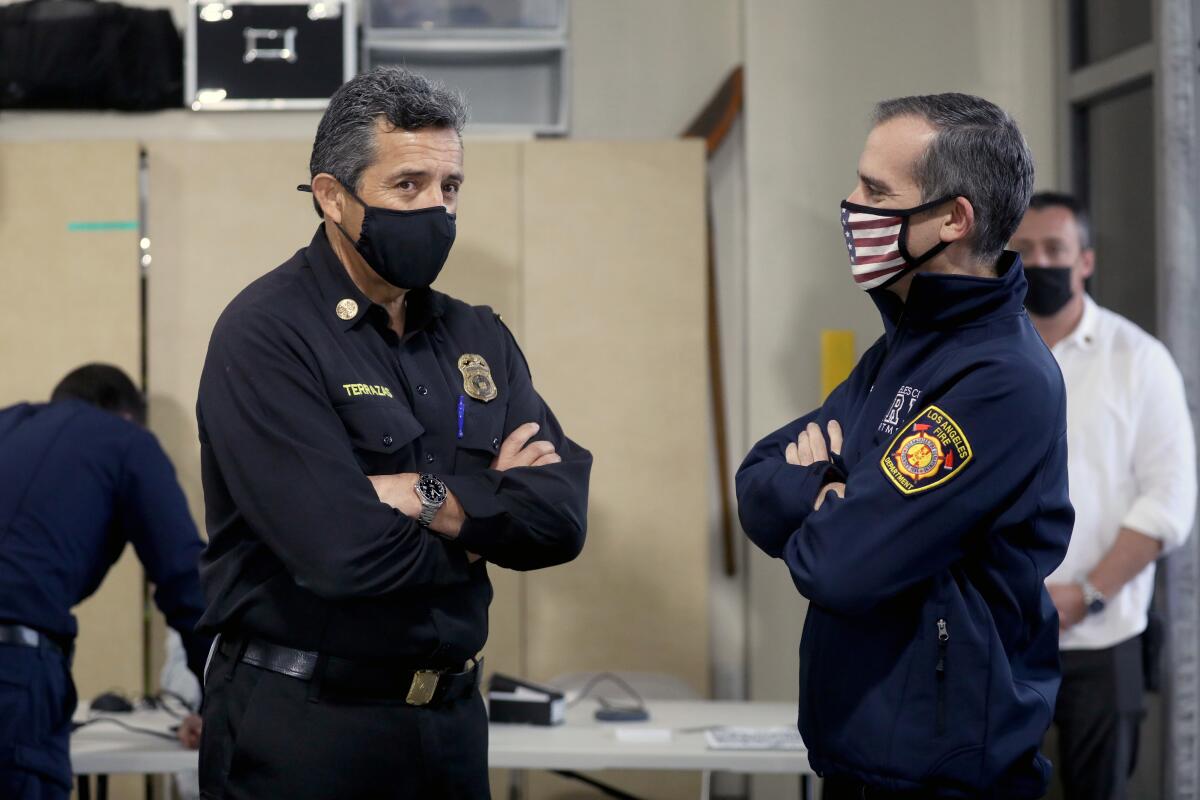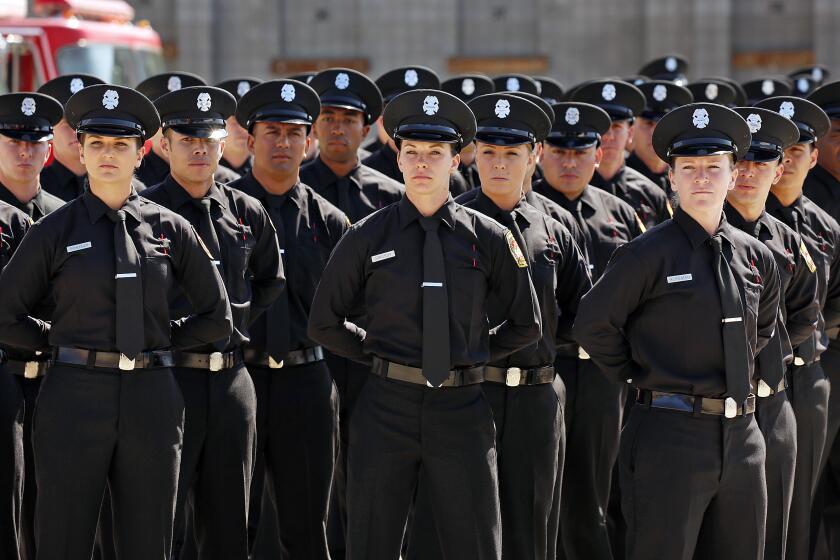Column: To anti-vax firefighters, bye-bye. Now let’s build back better at the LAFD

So let’s say that in two weeks, hundreds of Los Angeles city employees still defy the COVID-19 vaccination mandate.
What then?
Well, we don’t know exactly. Wimpy city officials, who already moved back the compliance deadline in the face of resistance, still haven’t spelled out consequences for those who don’t comply by Dec. 18. Already, some city employees — including firefighters — are off-duty without pay for failing to sign notices informing them of the deadline.
For the sake of argument, let’s say that in the Fire Department, where more than 500 members filed a lawsuit protesting the mandate, a few hundred stick to their guns and refuse the jab.
I say bye-bye, and good luck finding a firefighting job that pays as handsomely. And let’s hope the Cro-Magnon who allegedly took his mandate notice, wiped himself with it and dropped it on the floor of a station house in Pacific Palisades is the first to go. He’s on administrative leave while the department investigates.
Firefighter union president Freddy Escobar warned of a “devastating” public-safety risk if hundreds of firefighters are lost.
But that’s unlikely. Chief Ralph Terrazas told me that with some juggling here and some maneuvering there, he can cover the field while the department fills the vacancies.
But if, say, 100, 200 or 300 firefighters stick to their guns and quit, this could be a tremendous opportunity for the department to realign and better serve the public.
Firefighters who leave could be replaced by paramedics.
Why would that make sense?
The department is investigating a firefighter who is accused of a vulgar act after being given a letter to comply with the city’s vaccination mandate.
Because it’s easier, quicker and cheaper to hire paramedics than firefighters. And more important, because 85% of the calls are for medical issues rather than for fires, per the LAFD. That’s part of a national trend, and metro agencies across the nation have been shifting resources and strategies to serve changing needs.
That’s why Andrew Glazier, a former member of the Board of Fire Commissioners, sees a potential mass departure as an opportunity rather than a problem.
“If you lose several hundred people, and you refuse to change your operating model, then, yeah, you’ll have a big problem,” said Glazier. “But … if they were willing to add single-function paramedics to the department, you can hire them up and have them in the field in six weeks or less, and you can continuously hire them as needed.”
Glazier, who was appointed by Mayor Eric Garcetti, asked a lot of tough questions about department policy and advocated unsuccessfully for greater emphasis on medical services, but he was rebuffed. He paid a price for not being a City Hall stooge and rolling over to the wishes of the administration and firefighter union: Garcetti replaced him.
But let me get back to why Glazier uses the term “single-function” paramedics. It used to be that the LAFD had two main job classifications: You were a firefighter or a paramedic, not both. That changed in the mid-1990s, when paramedics were given firefighter training.
Today, all LAFD firefighters have basic medical training, and many have also become paramedics, which involves more advanced training and comes with a big boost in pay. The dual training can be a great benefit, because there’s a ready response for either fires or medical emergencies.
But it’s an expensive model, and Glazier is not alone in thinking that some changes might be in order. Steve Knight, vice president of the fire consulting company Fitch & Associates, said the New York City Fire Department is exploring options to better align resources to meet changing needs.
Knight said that over the last few decades, the number of fire calls has decreased dramatically, while emergency medical calls have soared, and among the alternatives in play is a public-private partnership, in which emergency medical services are contracted.
A former high-ranking LAFD official told me that not only are more than 8 in 10 calls medical in nature, but the vast majority do not involve life-threatening issues.
“Probably 70% of them don’t even require paramedic skills,” said the former official. He added that there is long-standing opposition to hiring single-function medics by the firefighters union, which would rather maintain higher-paying positions and avoid losing members to a medic unit not represented by the union.
Escobar confirmed his opposition to hiring more single-function medics. He told me by email that they wouldn’t necessarily be easy to come by and would still need training in department operations, and he argued that the greater need is for firefighters and firefighter/paramedics.
Terrazas told me he would oppose replacing firefighters with single-function medics, in part because he thinks it would be difficult to maintain personnel diversity goals. But that was disputed by the former fire official and Glazier; both said that hiring female paramedics, in particular, would help address a department shortfall.
A greater emphasis on medical services might also help trim overtime costs, which are both outlandish and legendary at the LAFD, which tops all departments in annual OT costs, according to a recent audit by the city controller. It’s expensive to have multiple firefighter/paramedics — who are often on the overtime clock — roll out to a medical call that turns out to be little more than a stubbed toe.
Kenneth Mejia, an accountant who’s running for city controller, dug into records recently and tweeted a list of top earners on the L.A. city payroll between Jan. 1 and the end of September.
Eighteen of them are in the Fire Department. And each of them hauled in more than $500,000 in nine months.
That is not a typo.
The amount represents more than just salary and overtime. It includes healthcare benefits, retirement benefits and other sweeteners. But the overtime amounts are staggering.
Many Los Angeles Fire Department employees lack trust in the agency’s leadership and more than half of the LAFD’s female sworn personnel cite bullying and harassment as a source of conflict, according to a new survey.
One LAFD captain made $385,000 in overtime alone in those nine months. In all, six firefighters made more than $300,000 in overtime alone, seven made more than $200,000, and four pulled in more than $100,000.
With those kinds of numbers; squadrons of LAFD members living out of state; a recent audit of overtime issues at COVID testing sites; and claims of harassment, discrimination and a frat-house culture, I think it’s safe to say this is not a particularly well-managed department.
When I asked LAFD spokeswoman Cheryl Getuiza about the half-million-dollar leader board, she emailed me a response.
“The LAFD members on this list have worked multiple overtime shifts, either filling a field vacancy or working in our COVID Division,” she said.
Yeah, it’s quite a gravy train.
And although the work of firefighters can be grueling and dangerous, it’s astounding that hundreds of public safety employees might opt out rather than take a safe and effective vaccine in the middle of a pandemic.
But like I said, that’s not a problem.
It’s an opportunity.
More to Read
Sign up for Essential California
The most important California stories and recommendations in your inbox every morning.
You may occasionally receive promotional content from the Los Angeles Times.













